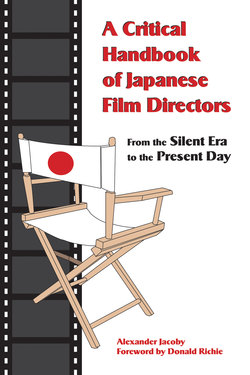Читать книгу A Critical Handbook of Japanese Film Directors - Alexander Jacoby - Страница 29
HIGASHI Yōichi
Оглавление(b. November 14, 1934)
東陽一
Known in the West mainly for one film, Village of Dreams (E no naka no boku no mura, 1996), Higashi has in fact produced an oeuvre of consistent intelligence and unobtrusive political commitment along liberal and progressive lines. His feature debut, People of the Okinawa Islands (Okinawa rettō, 1969), was hailed by Joan Mellen as “aesthetically the single finest example of the new documentary [then] emerging in Japan.” Using a hidden camera to record forbidden footage of American installations, Higashi produced a critical examination of the continuing U.S. military presence on Okinawa at the time of its reversion to Japanese rule. His next film and first fiction feature, Gentle Japanese (Yasashii Nipponjin, 1971), also dealt with the legacy of the Okinawan experience in World War II; it recounted the political awakening of a young man who, as a baby at the time of the defeat, had survived a mass suicide on the island. In Satori (Nihon yōkaiden: Satori, 1973), Higashi used a supernatural story to examine the anxieties of modern Japanese.
Higashi’s most critically acclaimed film in Japan was Third (Sādo, 1978), a powerful semi-documentary study of the life of a juvenile murderer in a reformatory, scripted by Shūji Terayama. The extreme understatement of Toshiyuki Nagashima’s lead performance, and the precision with which the camera picked out details in the bare prison environment, gave some scenes a near-Bressonian austerity. After this, Higashi switched his focus to women protagonists in a sequence of subtly feminist films. No More Easy Going (Mō hōzue wa tsukanai, 1979) was a melodrama about a college student who, torn between two unsatisfactory lovers, finally learns that she must live without them both. Natsuko (Shiki: Natsuko, 1980) subtly chronicled a 20-year-old woman’s quest for personal and professional fulfilment, while Manon (1981), vaguely inspired by the Abbé Prévost’s novel, followed the protagonist’s relationships with numerous men. Second Love (Sekando rabu, 1983) was about a woman trying to deal with the unmotivated jealousy of her insecure, younger second husband. These films were noted for their unusually strong heroines. In contrast, The Rape (Za reipu, 1982) and Metamorphosis (Keshin, 1986) dealt with the oppression of women in a patriarchal society.
During the nineties, Higashi adapted Sue Sumii’s epic novel, The River without a Bridge (Hashi no nai kawa, 1992), set in the Meiji and Taisho periods, about discrimination against the burakumin underclass. The same theme was touched on obliquely in Village of Dreams, a delicate account of the childhood of twin brothers in rural Shikoku during the late forties. Despite its hints of social criticism, the ultra-picturesque settings and elements of magic realism (the group of witches perching in the trees to comment on events) slightly over-sweetened the tone, but the film was atmospheric and affecting. In The Crying Wind (Fūon, 2004), Higashi used the same magical realist approach in a return to the Okinawa setting of his earliest features. The adult stories, in which now elderly protagonists come to terms with their memories of wartime traumas, were somewhat glib, but Higashi again showed his skill at dramatizing the intense emotional lives of children. My Grandpa (Watashi no guranpa, 2003) focused on a slightly older child, tracing the experiences of a 14-year-old girl ostracized at school after the discovery that her grandfather is a murderer. Again, this film revealed Higashi’s consistent sympathy for the outsider. Although his work is arguably more interesting in subject matter than in style, he commands respect for his intelligence and integrity.
1963 A Face (short)
1964 Higashi-Murayama-shi / Higashi-Murayama City (short)
1967 Jōdō / Motion-Emotion (short)
1969 Okinawa rettō / People of the Okinawa Islands (lit. Okinawa Archipelago)
1971 Yasashii Nipponjin / Gentle Japanese
1973 Nippon yōkaiden: Satori / Satori / A Japanese Demon / Spiritual Awakening
1978 Sādo / Third / Third Base / A Boy Called Third Base
1979 Mō hōzue wa tsukanai / No More Easy Going
1980 Shiki: Natsuko / Natsuko / The Four Seasons of Natsuko (lit.)
Rabu retā / Love Letter
1981 Manon
1982 Za reipu / The Rape
Jerashī gēmu / Jealousy Game
1983 Sekando rabu / Second Love
1984 Wangan dōro / Coastal Road
1986 Keshin / Metamorphosis
1988 Ureshi hazukashi monogatari / A Tale of Happiness and Shame
1992 Hashi no nai kawa / The River without a Bridge
1996 E no naka no boku no mura / Village of Dreams (lit. My Village in the Picture)
2000 Boku no ojisan / The Crossing (lit. My Uncle)
2003 Watashi no guranpa / My Grandpa
2004 Fūon / The Crying Wind
